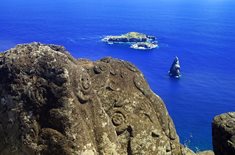
The story of isolated Easter Island is almost a biblical parable. Uninhabited for millennia, volcanic Easter Island was settled by intrepid Polynesian explorers - the Rapa Nui who discovered the lush and verdant island teaming with plentiful game and thick forests.
The Rapa Nui practiced an intense form of ancestor worship, carving titanic rock statues of their forbearers called
moai out of the pliable volcanic stone of the island. With great effort and precision, the Rapa Nui erected these
moai with their backs to the sea, some of which still loom over the crashing surf today. The Rapa Nui believed that by worshiping them the ancestors would protect and bless the Rapa Nui with the boundless fertility of the island.
Tragically, the large-scale
moai construction was directly responsible for the near destruction of the island. Moving the massive sculptures from their quarries to the sea required felling countless trees, smearing them in oil, and rolling the
moai into position. Centuries of construction led to the complete deforestation of the island. Frustrated, and no doubt frightened, the Rapa Nui turned on their ancestors, smashing and decapitating the massive statues. A new cult began to emerge; one which focused on establishing a divine right of clan leadership, and access to the scant resources of the island. This was the cult of the Bird Man, or
Tangata Manu.
Off the coast of Easter Island are three islets, home in the austral summer to a host of migratory birds including the sooty turn. It is easy to see why the Rapa Nui, coping with their isolated island’s increasing scarcity, might have looked at the birds of the air, with their power and freedom to leave the isolated island, as creatures more divinely blessed than they were.
The Bird Man cult centered on an annual test of strength and endurance. Each clan put forward a candidate, who was required to descend a sheer cliff, swim more than a mile in shark-infested water to the islets, capture the a newly-laid tern egg, then swim back, carrying the egg in a basket on his head. The winning clan was the undisputed leaders of the island until the next autumnal equinox, their right to first pick of the island’s resourced assured by their victorious Bird Man who lived isolated in a special house forbidden to bathe or cut his hair or fingernails.
This self-imposed practice of survival of the fittest ensured the continued existence of the Rapa Nui until 1862, when slave traders carried off many of the strongest islanders. Later, missionaries bent on bringing Christianity to the islanders brought contagious diseases which finished off all but a few of the Rapa Nui.
Speak to a knowledgeable Alexander+Roberts reservation agent about planning a once-in-a-lifetime trip to Easter Island on the signature
Easter Island & Patagonia.